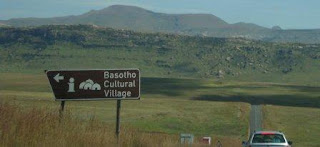Its been quite some time that i have updated my blog, here i am coming with some thing interesting.
Basotho Cultural Village, I had an opportunity to visit this fabulous place where the lifestyle and architecture of the South SeSotho is accurately depicted here, which is open to the public.

The village is situated 20 km from the Golden Gate National Park and lies within the QwaQwa
National Park. The Cultural Village is like a walk down the pathway of time. The main display at the village is a courtyard of Basotho huts from the sixteenth century to the present day, with people in traditional dress, playing different roles. The guided tour will take us into the "khotla", the gathering place of men. The Basotho are very hospitable people. We will also have the opportunity to consult the "ngaka", the captain's advisor, in his professional capacity as traditional healer.

The huts are built and furnished according to the time frame depicted by each one. The Basotho women do the interior and exterior decoration of huts. It is called "litem" and can still be admired on a drive through the Free State rural areas. The colours are extremely vibrant and dramatic.
Passing thru the village we will frequently see a flag flying from a tall pole. This indicates a place where something is being sold. A white flag means "joala", a locally brewed sorghum beer. Yellow means maize beer, red means meat and green means vegetables.

The Basotho nation emerged from the unification of a number of smaller southern SeSotho clans by King Moshoeshoe at the beginning of the nineteenth century. Their language, seSotho, is a mixture of Zulu and Tswana. They came to live here during the great exodus of people from the ferocity of Shaka the Zulu.

Villages are very structured. They are made up of a number of kraals, i.e. a collection of buildings belonging to one family. Some are for sleeping, some for storage and one for cooking. Each kraal will also have an enclosure for livestock. Each village has a chief, or headman, who will fall under the chief for the area. I had an opportunity to wear the outfit of the "Chief" that is depicted in this photograph.
The Chief will have three wives, the chief will choose his first wife and she will select his second wife and the people of village will select his third wife. The three wives of Chief live in same compound but in different huts, Chief had to make a prior appointment to meet any his wife.
Basotho are agriculturalists. The chief allocates the fields around the villages to villagers. Many crops are cultivated including maize, wheat, sorghum, beans & peas as well as vegetables such as onions & cabbage. Many local herbs are
also gathered as green vegetables, which the Basotho call Moroho.
Animals are very important in Basotho society. The Basotho pony represents the best form of transport in the mountains, and donkeys are often used as pack animals. Oxen are used to plough the sloping mountain fields. Wool is a major source of income both from Merino sheep and mohair from Angora goats. Shepherds, who are often young boys, look after them.

The Basotho consult traditional doctors (called sangomas) to receive remedies for sickness, mixtures for prosperity, and counsel on appeasing their ancestors. Their services are offered in exchange for a fee. While sangomas have a deep knowledge of herbs and therapeutic techniques, they are also masters of black magic and the use of supernatural powers. Because of their ability to place curses and bring bad fortune, there is a fear of them and their powers. The Sangoma depicts the health & prosperity based on the position of the bones & shells that were throw infront of him by the person. In the picture the Sangoma is depicting the position of bones and shells thrown by me. The Sangomas get thier ability to be a Songoma as heriditary from their ancestors, others cannot practice this.

The Basotho have many unique traditions. Probably the most individualistic are the tribal blankets. They are still worn by the Basotho people today. They have specific blanket patterns for specific individuals as depicted in the picture.
It was a great experience to travel through the cultural village and to know about the culture and life style of Basotho.


No comments:
Post a Comment